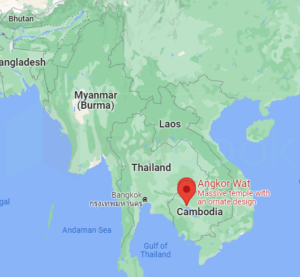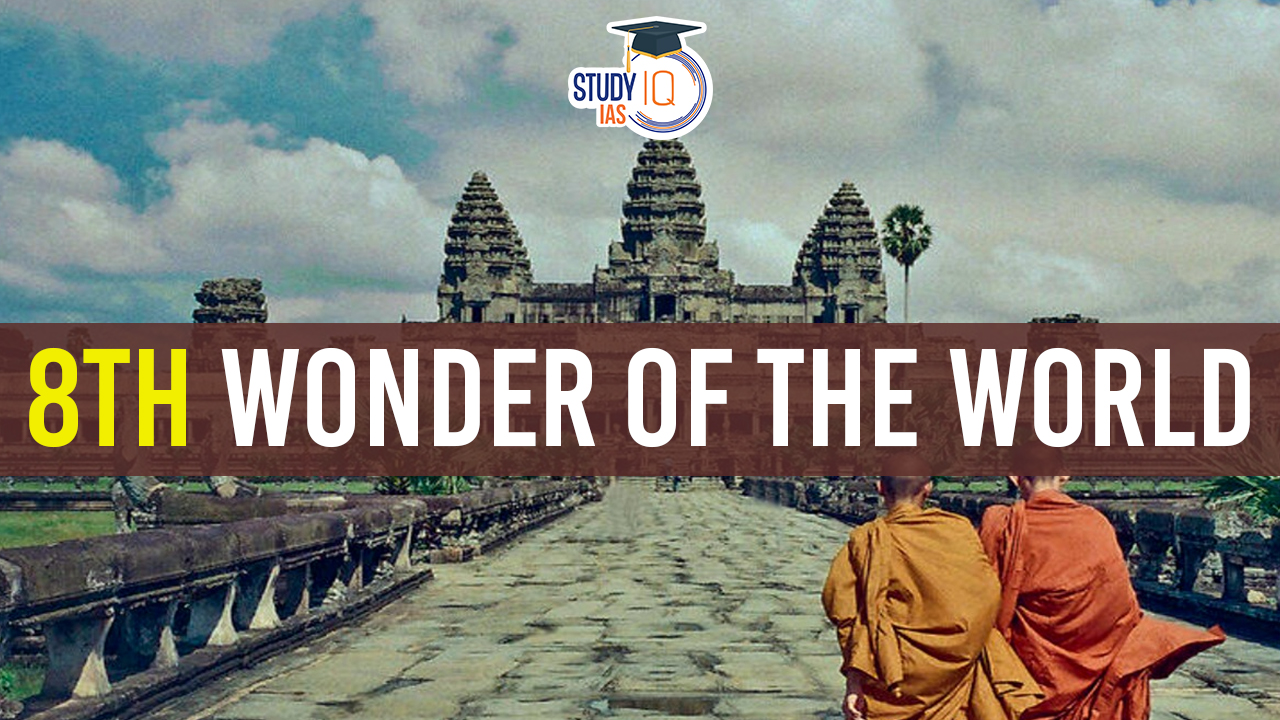Table of Contents
Cambodia’s Angkor Wat is now hailed as the 8th wonder of the world, It has surpasses Italy Pompeii for this prestigious title. Recognized for outstanding buildings or projects, Angkor Wat’s architectural and historical significance secured its place among the world’s wonders, marking a significant achievement for Cambodia’s cultural heritage.
We’re now on WhatsApp. Click to Join
8th Wonder of The World
In Cambodia, Angkor Wat proudly holds the Guinness World Record as the largest global religious structure. Recently designated as the eighth wonder of the world, it stands as one of the most visited attractions globally. Positioned at the core of Cambodia, Angkor Wat has surpassed Italy’s Pompeii, securing the title of the eighth Wonder of the World. This achievement holds added significance, considering Pompeii’s considerable annual tourist traffic.
The prestigious ‘8th wonder of the world’ title, typically reserved for exceptional new constructions or projects, now rightfully belongs to Angkor Wat, displacing Italy’s Pompeii from its former position.
Angkor Wat
Angkor Wat, an immense temple complex situated in northern Cambodia, was initially constructed as a Hindu temple dedicated to Lord Vishnu by King Suryavarman II in the early 12th century. However, by the close of the same century, it underwent a transformation into a Buddhist temple, now recognized as a Hindu-Buddhist Temple. Spanning approximately 400 acres, it stands as the world’s largest religious monument.

The name ‘Angkor Wat,’ translating to ‘temple city,’ is distinctive as it deviated from earlier Shaivism traditions, focusing on Vishnu. Unlike many historical sites, Angkor Wat didn’t face abandonment but gradually declined. Today, it holds immense significance for Cambodia, even featuring on the national flag. Revered for its extraordinary architecture, it has rightfully earned the distinction of being considered the eighth wonder of the world.
Angkor Wat Location
Angkor Wat is located in the northern part of Cambodia, near the city of Siem Reap. Siem Reap is the gateway to the Angkor region, which is home to the remains of the Khmer Empire’s capital cities, including the famous Angkor Wat temple complex. The coordinates for Angkor Wat are approximately 13.4125° N latitude and 103.8660° E longitude.
The temple complex is part of the larger Angkor Archaeological Park, which spans over 400 square kilometers and includes various other temples and historical sites from the Khmer civilization. Angkor Wat is a UNESCO World Heritage Site and a significant cultural and religious symbol in Cambodia.

History of Angkor Wat
- Construction (Early 12th Century): Built by King Suryavarman II around 1113-1150 AD.
- Hindu Influence: Originally a Hindu temple dedicated to Vishnu, reflecting Hindu cosmology.
- Transition to Buddhism (Late 12th Century): Under Jayavarman VII, transformed into a Buddhist temple with adaptations to iconography and bas-reliefs.
- Post-Angkor Period (15th Century Onward): Gradual decline, not immediate abandonment; continued as a pilgrimage site with Theravada Buddhist influence.
- European Discovery (19th Century): Rediscovered by French explorer Henri Mouhot, sparking international interest.
- Conservation and Restoration (20th Century Onward): UNESCO World Heritage Site designation in 1992; ongoing efforts to preserve and restore Angkor Wat.
- Modern Significance: Symbol of Cambodia, on the national flag; major global tourist attraction.
Architectural Wonder Angkor Wat
- Angkor Wat, the colossal architectural wonder in Cambodia, is an unparalleled testament to Khmer ingenuity.
- Spanning 400 acres, it boasts perfect symmetry, intricate bas-reliefs portraying Hindu epics, and five lotus-shaped towers symbolizing Mount Meru.
- This Hindu-Buddhist masterpiece, aligned with cardinal points, reflects advanced astronomical understanding.
- Beyond its visual grandeur, Angkor Wat holds spiritual significance and presents a breathtaking sunrise spectacle.
- However, conservation challenges persist, underscoring the need for ongoing efforts to preserve this UNESCO World Heritage Site and symbol of Cambodia’s rich cultural legacy.
Sunrise at Angkor Wat
Sunrise at Angkor Wat is a mesmerizing spectacle, luring visitors to Cambodia from across the globe. As dawn unfolds, the ancient temple is drenched in soft pinks, warm oranges, and radiant gold, casting a spellbinding reflection in its surrounding moat.
The silhouette of Angkor Wat’s towers against the vibrant sky creates a dramatic and awe-inspiring view. This magical moment, steeped in spiritual ambiance, draws crowds seeking both photographic opportunities and moments of quiet contemplation. The sunrise ritual, now a cultural tradition, symbolizes hope, renewal, and the enduring beauty of Angkor Wat, transcending time and capturing the essence of Cambodia’s rich heritage.
Angkor Wat Cultural and Spiritual Significance
Beyond its architectural grandeur, Angkor Wat holds immense cultural and spiritual importance. Despite being a popular tourist destination, it remains an active religious site, attracting Buddhist monks and devotees who come to pay their respects, engage in prayer, and participate in meditation. The statue of the eight-armed Vishnu within the temple is revered by locals as their protecting deity, adding to the site’s spiritual aura.
Seven Wonders of the World
The wonders of the world are truly astonishing, spanning various ages and origins. Some, like the ancient Great Pyramid of Giza and the Hanging Gardens of Babylon, represent remarkable architectural feats from bygone eras. In contrast, newer wonders, selected by a global consensus, include the Great Wall of China, Christ the Redeemer in Brazil, and the Taj Mahal in India.
Despite originating in different times and locations, these wonders universally captivate attention due to their exceptional beauty and significance. They serve as a testament to the incredible capabilities of humanity, creating structures that continue to amaze and inspire generations. Check here the Old and New Seven Wonders of the World in detail.
8th Wonder of The World UPSC
- Angkor Wat, crowned the eighth Wonder of the World, surpasses Italy’s Pompeii in architectural and historical significance, marking a triumph for Cambodia’s cultural heritage.
- Built as a Hindu temple, it later transformed into a Buddhist marvel, spanning 400 acres and standing as the largest global religious monument.
- Its unique name, translating to ‘temple city,’ deviates from earlier Shaivism traditions, featuring on Cambodia’s national flag.
- This UNESCO World Heritage Site and tourist magnet reflects Khmer ingenuity. Despite conservation challenges, Angkor Wat’s spiritual allure remains, symbolizing hope and renewal.
- Its recognition echoes among the world’s wonders, showcasing humanity’s awe-inspiring creations.


 Bharat Bandh 9 July 2025: Over 25 Crore ...
Bharat Bandh 9 July 2025: Over 25 Crore ...
 Sukhoi Su-57: Will India Choose Russia�...
Sukhoi Su-57: Will India Choose Russia�...
 World Bioproduct Day 2025: Date, Theme, ...
World Bioproduct Day 2025: Date, Theme, ...





















